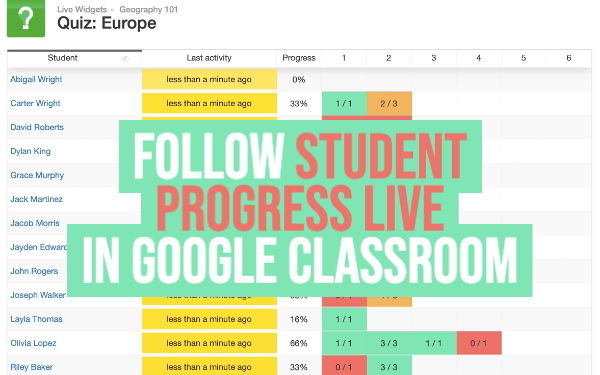Follow student progress live in Google Classroom
 Lucie Renard —
Lucie Renard —
When you create interactive exercises with BookWidgets, you are often interested in knowing how your students are doing, so you know how you can help your students to better understand your lessons. The classical way to do this is to hand out your widget as an assignment, let your students complete the assignment, submit their answers back to you, you review the work, and finally return your feedback. This works well for offline tasks such as homework, but you probably often find yourself in situations where you would like to know how your students are doing while they are doing their assignments. Knowing the progress of individual students and your whole class at all times allows you to immediately act when necessary.
With BookWidgets’ Live widgets, you can follow student activity in real-time from within any BookWidgets-supported LMS, including Google Classroom. With a simple glance, you can see the progress of your entire class on a particular widget, at the exact moment they are doing it, and you can dive into the details of specific students when necessary.
In this blog post, I’ll explain what live widgets are, why you would want to use them, how you use them in Google Classroom, and how you can apply them specifically for distance learning. I’ll finish with 10 creative lesson ideas for using Live Widgets.
BookWidgets & Google Classroom
Before talking about live widgets, let’s quickly recap what widgets are. With BookWidgets, you can create your own interactive exercises, or widgets. You choose one of the interactive exercise templates (such as quizzes, crossword riddles, timelines, etc.), fill them with your own content, and share them with your students. Some widgets allow your students to send their result back to you, so you can review it, grade it, and send it back to your students. By installing the BookWidgets Chrome plugin, you can create, share, and review widgets right from inside Google Classroom. To see how this works, check out this teacher webinar.
Live widgets
BookWidgets’ Live widgets gives you a new dashboard where you can see all the widgets your students are currently doing, in real-time:
You get a nice overview of the progress of all students in your class, in this case broken down by individual exercise. If you see a student that might need extra help, you can open their individual work, and see how they are doing.
Every widget shows its own interesting statistics for each student working on it. This includes:
Score/progress: See how students progress in the activity they are making at that moment: which students have finished quickly and which students fall behind or need more time? This also indicates when the time is right to move on to the next exercise or part of the lesson. You’ll see a progress bar, and the field will light up green when students finished the activity. For widgets that students can send back to you, you’ll also see an envelope icon when they submitted.

Questions: In quizzes and worksheets, you’ll get a score for each question in separate columns, colored by correctness: red (didn’t pass the question), orange (got half) or green (got everything right). Bringing together all the coloured fields in the row gives you a good idea whether your students understood the activity or not. This is where you remediate and help out struggling students, or give more challenging exercises to students that got everything right.

Last activity: By looking at the last activity, you can quickly see who is stuck on a widget, and check if they need extra help or instructions.

Details: Besides the class overview, you can open individual student work by clicking the name of the student. You’ll see exactly how this student is doing on this exercise, as they type their answers to each question. When you notice a student is stuck for a few minutes, open their details to see which question they are stuck. Or, when a student has a lot of red fields in the overview, check their details and point their mistakes out (in person), so they can turn the situation around.
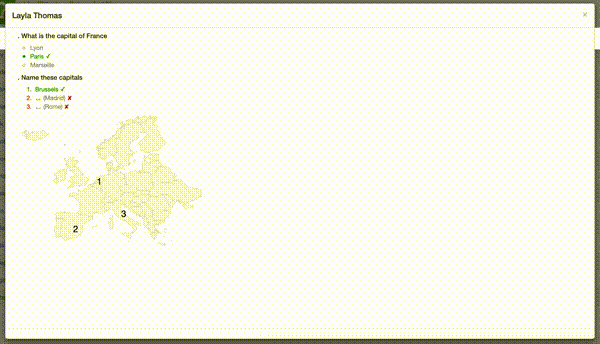
You can sort your list of students according to each of the available statistics at the top, letting you track your classroom based on progress, activity, or scores.
With live widgets, you don’t need to wait for your students to submit their widget to you before you get an idea of how your students are absorbing your lesson content and whether they understand it or not. And what’s more, this doesn’t only work for quizzes, but also works for many widget types that don’t have any results to send back to you (such as memory games, jigsaw puzzles, …).
Using Live widgets for distance learning
When you are teaching in a classroom, you can let your students practice the material with all kinds of widgets, and walk around the room to see how everyone is doing. When teaching remotely, however, walking around isn’t possible, and you’re typically left to assignments with submissions to get an idea of your students’ understanding.
Thanks to live widgets, you can now virtually watch over your students’ shoulders while they are practicing. Live widgets can replace some of the advantages you lose when not teaching in a traditional classroom: quickly discovering and helping struggling students, making sure students are being challenged enough, spark engagement, …
Here are some ways in which you can use live widgets for distance learning:
- As a quick check-up: Check upon students to see if they are working on assignments or not. The statistics give you a clear overview of the level of understanding of your students.
- For remediation: If you want more interaction from a distance, you can use Live widgets (in Google Classroom), in combination with Hangouts meet. Give a live lesson using Hangouts meet, let students make the assigned BookWidgets exercise in Google Classroom, and immediately check your students’ work. The statistics and details show you which students need help. Use the private chat function in Hangouts to provide a helping hand to students that need it (e.g. extra instructions, pointers to materials, …). Additionally, you can assign more challenging exercises to the students that finish quicker than the rest of the class.
- To engage: Share your Live widgets dashboard with students by sharing your screen in Hangouts Meet. Blur the student names (by clicking on the eye) and pick out the work of one of the students. Open the details, and ask your students to give feedback on the work of this student, so they can learn from each other.
How to enable Live widgets in Google Classroom
Before you can use live widgets, you have to enable them. You can do this from your account page, or by clicking the BookWidgets Chrome plugin icon in your Chrome browser to access your live widgets dashboard. After you enabled Live Widgets, all of your widgets that have activity in the last 12 hours will be available in this same dashboard.

10 Creative lesson ideas with Live widgets
Digital classroom races: Use game widgets (such as Crossword, Word search, Pair matching, Jigsaw, and Memory) to hold “races”. Show the score dashboard of Live widgets to your students (or share it through Hangouts), and let them play your educational game. Optionally, blur the names, and pick out the winner to classically correct the answers in the game.
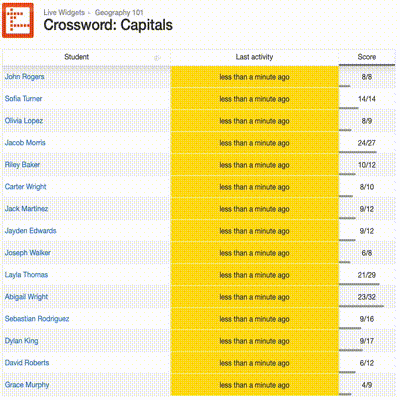
Pictionary: Assign a Whiteboard widget in Google Classroom. Pick out a student, and tell them to draw something about the current lesson. Open the live widgets dashboard to see them draw live, and share the dashboard on the classroom screen so everybody can see the student drawing.
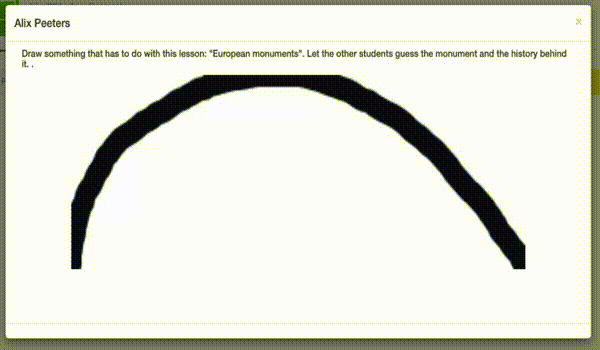
Differentiate by levels of understanding: Look at the live results after an assignment or evaluation. Use the statistics to find out which students are slow to solve the assignment, which students make many mistakes (and don’t understand well what they were taught), and which students finished earlier than the rest without mistakes. Use this information to split up your students into different groups: groups that get more time to work on exercises, groups that get more instructions from you, and groups that get more advanced assignments on the same material.
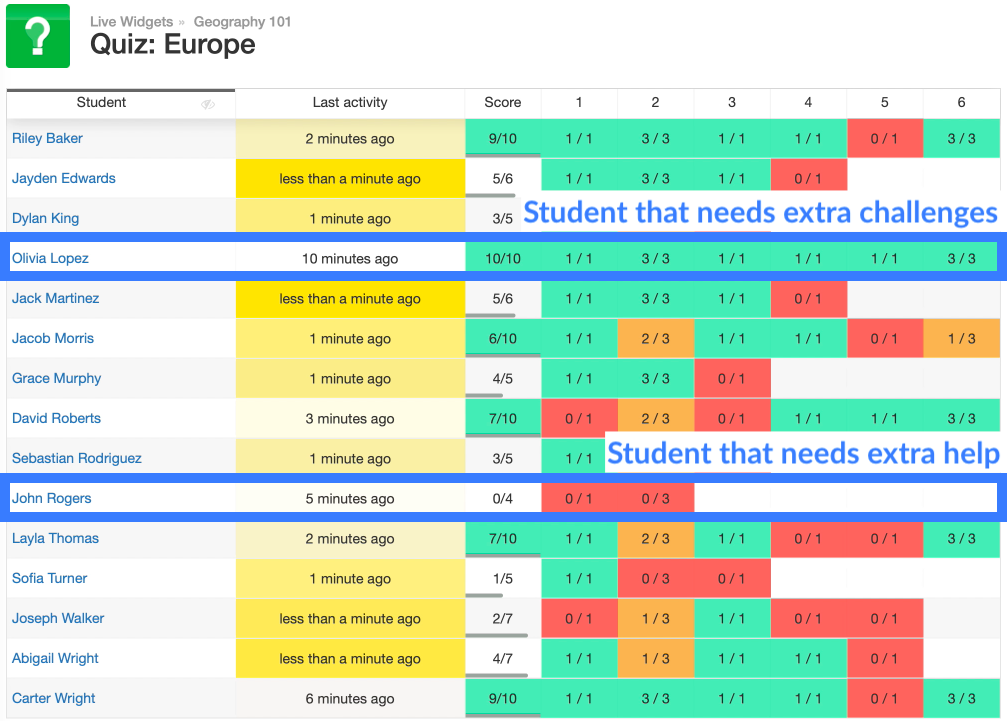
Short (anonymous) surveys: Assign an Exit slip widget in Google Classroom to quickly evaluate how students understand your lesson, by asking them to score with a smiley face. By looking at the results, you can get an impression how well your class processed lesson. Before building upon previous knowledge in the next lesson, you give extra instructions to the students that responded with a sad face (red field), so you can make sure they can continue learning. You can also pair up students that answered with a happy face (green field) with students that felt neutral (orange field), and let green students explain the lesson to the orange students again. You can blur student names to make the survey anonymous by clicking on the “Eye” icon.
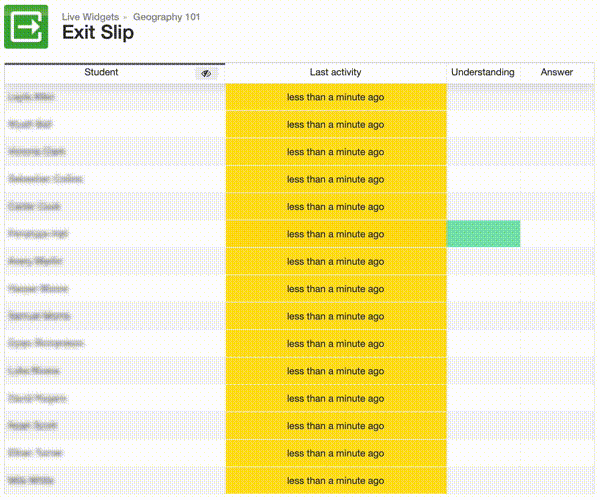
Drawing answers: When you don’t have small whiteboards to hand out to students to draw their answers on and show it to you in class, use a Whiteboard widget as a personal digital answer board. Assign the digital whiteboard widget in Google Classroom and let your students open it on their smartphone, chromebook, tablet, or PC. Ask a question about the lesson topic, set a timer (for example 20 seconds), and let students write down or draw their answer to your question on their whiteboard. Look at their drawings in your live widget dashboard, and pick out a few students to explain their answers.
Elaborate: After your students completed a quiz, blur the student names in the Live widgets dashboard and share your screen with everyone. Pick out some works that are incorrect, and ask your students to elaborate on the current work: what is the correct answer? what’s the theory behind this answer? Then, show a correct answer, and let them elaborate on that. Finally, ask all your students to improve their answer, and see if they truly learned something.
Group work check-up: With a Planner widget, you can assign tasks that students can tick off when finished. Use a Planner to encourage group work by pointing out step-by-step what students have to do. The live widgets dashboard will show you where students are in the process, and which steps they ticked off already, allowing you to easily follow up on progress in each group.
Summarize a lesson: Create a Mind map widget with the topic of your lesson drawn in the center. While you are teaching, students open their mind map and start adding associations and keywords to the mind map, building up a complete summary of the lesson. From time to time, you can take a peek at the live widgets results, pick out a few students, and let them explain their mind map. You can show their mind map on the big screen so everyone can complete it with things they had on their own mind map.
Distance learning log: Assign an empty timeline in Google Classroom, and ask your students to create a log of their homework. Let them add a new event to their timeline every day, and write down what they did for school. Follow up your students logs daily from the live dashboard. If your students don’t have something to log every day, you can occasionaly check live student activity, but let everyone submit their timeline to you at the end of the week.
Status / Help button: Use an Exit slip widget as a way for students to indicate how they are currently doing in class, and to ask for help. They can open this widget at any time during the lesson, and click on one of the smiley faces to tell you how they are doing:
- ☹️ (Red): The student is stuck, and needs your help
- 😐 Neutral (Orange): The student doesn’t understand a question, but can still continue working on other exercises in the assignment.
- 😁 Happy (Green): The student understands everything just fine, and can move on.
By monitoring your live widgets dashboard, you can immediately know who needs help, or let students with a green indicator help out students with an orange one.
Conclusion
Using Live widgets in Google Classroom makes it easy for you to track student progress and to keep an eye on their work when you are teaching from a distance, and open up a whole new way of using widgets in your class. And if you don’t use Google Classroom: you can use Live widgets in other LMSes as well (Microsoft Teams, Canvas, Moodle, Schoology, …)
